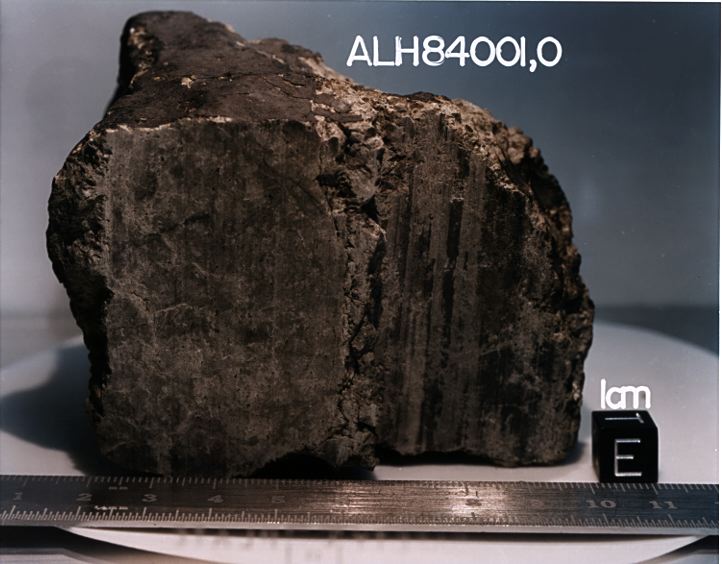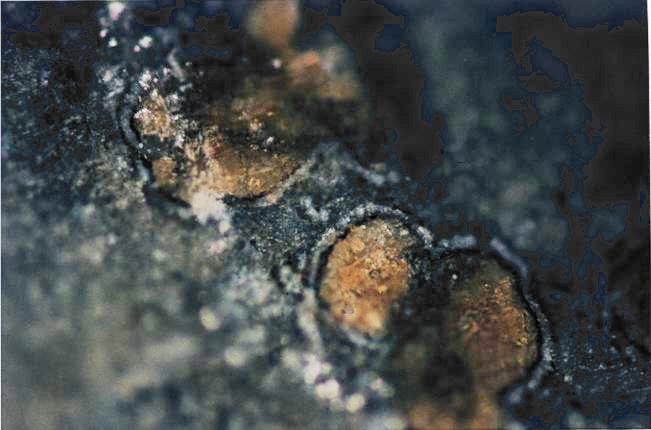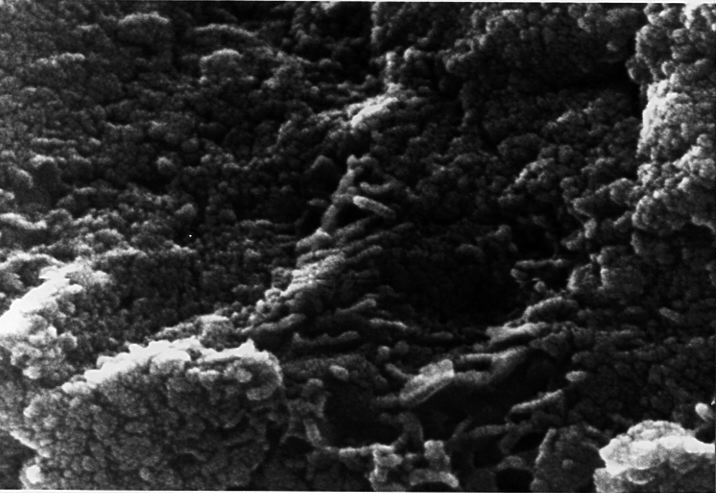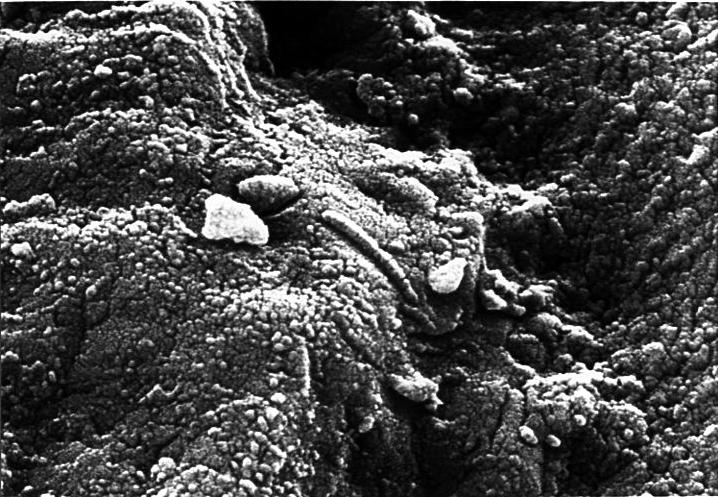Life on Mars?
Mars has been a favorite place for speculations about life for
centuries, right through the canal controversy. In the 20th century,
things got more complicated when it became clear that the Martian
atmosphere was much too thin to support Earth-style respiration
(and, by such expedients as carrying telescopes to the summit
of Mt. Whitney, astronomers learned there was no measurable water vapor in the
Martian atmosphere).
The environmental conditions are formidable - atmospheric pressure
less than 1% of the Earth's, too little to warm the surface through
a greenhouse effect, and this almost entirely carbon dioxide. The diurnal
temperature swings are huge, though most parts of the planet don't
get above the freezing point of water. Most of the solar ultraviolet
radiation reaches the surface unimpeded by the tiny amount of ozone
in the atmosphere. When people describe Mars as the most hospitable
of the other planets, this might be more accurately translated as "not trying
to kill you as hard as the others".
Still, experience on Earth has taught us that life is very hardy
and can survive in the most unlikely niches, such as undersea volcanic
vents and boiling volcanic hot springs (not to mention bathrooms,
as anyone can attest who's tried disinfecting one). Any place with remotely
hospitable conditions is worth examining, especially with the
kind of evidence seen on Mars for a friendlier past. The Viking missions
were designed with searching for life as their major task, and
maybe their biggest lesson was that we didn't know enough about
chemistry or biology 30 years ago to ask the right questions.
 A new thread came into the discussion
with the realization
that we already have Martian samples in the lab. A few
meteorites
have been found to have chemistry matching the Martian surface
(and trapped gas bubbles matching the Martian atmosphere). Amid
much controversy, and a presidential opening statement, a group
of NASA and university scientists
concluded in 1997 that one such
rock, found in the Alan Hills of Antarctica and known as ALH84001,
showed chemical and fossil evidence of Martian life from 3.5 billion
years ago.
A new thread came into the discussion
with the realization
that we already have Martian samples in the lab. A few
meteorites
have been found to have chemistry matching the Martian surface
(and trapped gas bubbles matching the Martian atmosphere). Amid
much controversy, and a presidential opening statement, a group
of NASA and university scientists
concluded in 1997 that one such
rock, found in the Alan Hills of Antarctica and known as ALH84001,
showed chemical and fossil evidence of Martian life from 3.5 billion
years ago.
 The chemical evidence is a bit abstruse, involving
carbonates (minerals deposited only in water, to my mind the most
important result), and magnetite, which is still known in similar
crystals on Earth only when deposited by bacteria, appearing in
tiny globules about 0.25 mm across (right). What grabbed most
people's attention, though, were the electron micrographs showing
tiny structures that look remarkably like microorganisms or
microfossils. These are smaller than it was thought free-living
terrestrial organisms could be, an objection that has shrunk with the
study of nano- (or nanno-)bacteria. Still, despite the best
practice in analysis and the pristine Antarctic environment,
there's always lingering suspicion of terrestrial contamination.
To the extent that there is a consensus among astrobiologists,
it seems to be that the evidence for biological origin of these
structures is not as compelling as originally thought.
The chemical evidence is a bit abstruse, involving
carbonates (minerals deposited only in water, to my mind the most
important result), and magnetite, which is still known in similar
crystals on Earth only when deposited by bacteria, appearing in
tiny globules about 0.25 mm across (right). What grabbed most
people's attention, though, were the electron micrographs showing
tiny structures that look remarkably like microorganisms or
microfossils. These are smaller than it was thought free-living
terrestrial organisms could be, an objection that has shrunk with the
study of nano- (or nanno-)bacteria. Still, despite the best
practice in analysis and the pristine Antarctic environment,
there's always lingering suspicion of terrestrial contamination.
To the extent that there is a consensus among astrobiologists,
it seems to be that the evidence for biological origin of these
structures is not as compelling as originally thought.
In the meantime, terrestrial biology has learned much about organisms
in extreme environments on our own world. Hot springs, the deep ocean,
sulfur-rich caves,
the Antarctic, all have shown hitherto unsuspected organisms, often
very tiny and related only distantly to the larger life forms we
usually encounter. These findings make it more plausible that life
could exist in exotic places (whether it could originate there
or not), and improve the likely odds that any life starting out on a
warm and wet Mars could survive the gradual freeze-drying of the planet.
An obvious next step would be a proper analysis of samples
of Martian soil and rock (in case anything's hiding in the pores).
This would require picking up the rock from a known place on Mars and
returning it to Earth. (For a while, NASA and the Centers for Disease
Control were arguing about who was better equipped to deal with such
analysis, and I kind of liked the vision of a Martian sample re-entering
toward downtown Atlanta.) Plans were moving along, when the whole scheme
was stalled by the failures of Mars Climate Orbiter and the Polar
Lander in 1999. The scheme required four launches from three
countries to all work over a five-year period, anyway, with a
European probe finally picking two grapefruit-sized canisters
out of Mars orbit for a return to the Utah desert. You can
read about the revised plans at NASA's
Mars Exploration site.
Should we worry about the Andromeda Strain? What if we
return Martian organisms that we have no defenses against?
Not only is it unlikely that any response could cross
not just species, but biospheres, easily, but the fact that there
are Martian meteorites known on Earth says that some such
organisms have made the trip in the past - and we're still
here. Unless we're the Martians, which would explain a
lot of political headlines these days.
Sample return is still a priority, so maybe in a decade or
so we'll see something happen. Of course, sending scientists
there would still be much
more flexible and productive, but there seem to be no plans
that would get this done anytime soon. With our current
technology the process would be expensive and slow - launch
something the size of Mir on a three-year round trip.
For this to work, food would need to be grown on board,
and water recycled very efficiently - it wouldn't pay to think
too deeply about where that last sip came from, not that it
does in a modern city either. The psychological problems are
also profound- as one veteran of Mir said, a long-duration
space mission presents all the ingredients for murder.
By now it's pretty clear that any life on Mars would be
in the form of microorganisms - strange and exotic bacteria,
more or less. If it's not big enough or smart enough to
say "Take me to your leader?", why would we care? Mostly because
having two worlds to examine is a lot different than one.
Do all these life forms have the same chemistry? If so, does
that mean both started out ono the same world and somebody
hitch-hiked off on a meteor, or that there really is only a
single chemical basis for life possible? And going further,
if life could appear on two worlds in one system, the odds start
to look better for finding it elsewhere - the buried oceans
of Europa, and worlds in the planetary systems that have been
found around
many sunlike stars in the last
few years. These are
the ones that we might really be interested in meeting.
Marsfest |
Bill Keel |
UA Astronomy |
Dept. of Physics and Astronomy |
University of Alabama
keel@bildad.astr.ua.edu
Last changes: August 2003
 A new thread came into the discussion
with the realization
that we already have Martian samples in the lab. A few
meteorites
have been found to have chemistry matching the Martian surface
(and trapped gas bubbles matching the Martian atmosphere). Amid
much controversy, and a presidential opening statement, a group
of NASA and university scientists
concluded in 1997 that one such
rock, found in the Alan Hills of Antarctica and known as ALH84001,
showed chemical and fossil evidence of Martian life from 3.5 billion
years ago.
A new thread came into the discussion
with the realization
that we already have Martian samples in the lab. A few
meteorites
have been found to have chemistry matching the Martian surface
(and trapped gas bubbles matching the Martian atmosphere). Amid
much controversy, and a presidential opening statement, a group
of NASA and university scientists
concluded in 1997 that one such
rock, found in the Alan Hills of Antarctica and known as ALH84001,
showed chemical and fossil evidence of Martian life from 3.5 billion
years ago.
 The chemical evidence is a bit abstruse, involving
carbonates (minerals deposited only in water, to my mind the most
important result), and magnetite, which is still known in similar
crystals on Earth only when deposited by bacteria, appearing in
tiny globules about 0.25 mm across (right). What grabbed most
people's attention, though, were the electron micrographs showing
tiny structures that look remarkably like microorganisms or
microfossils. These are smaller than it was thought free-living
terrestrial organisms could be, an objection that has shrunk with the
study of nano- (or nanno-)bacteria. Still, despite the best
practice in analysis and the pristine Antarctic environment,
there's always lingering suspicion of terrestrial contamination.
To the extent that there is a consensus among astrobiologists,
it seems to be that the evidence for biological origin of these
structures is not as compelling as originally thought.
The chemical evidence is a bit abstruse, involving
carbonates (minerals deposited only in water, to my mind the most
important result), and magnetite, which is still known in similar
crystals on Earth only when deposited by bacteria, appearing in
tiny globules about 0.25 mm across (right). What grabbed most
people's attention, though, were the electron micrographs showing
tiny structures that look remarkably like microorganisms or
microfossils. These are smaller than it was thought free-living
terrestrial organisms could be, an objection that has shrunk with the
study of nano- (or nanno-)bacteria. Still, despite the best
practice in analysis and the pristine Antarctic environment,
there's always lingering suspicion of terrestrial contamination.
To the extent that there is a consensus among astrobiologists,
it seems to be that the evidence for biological origin of these
structures is not as compelling as originally thought.

